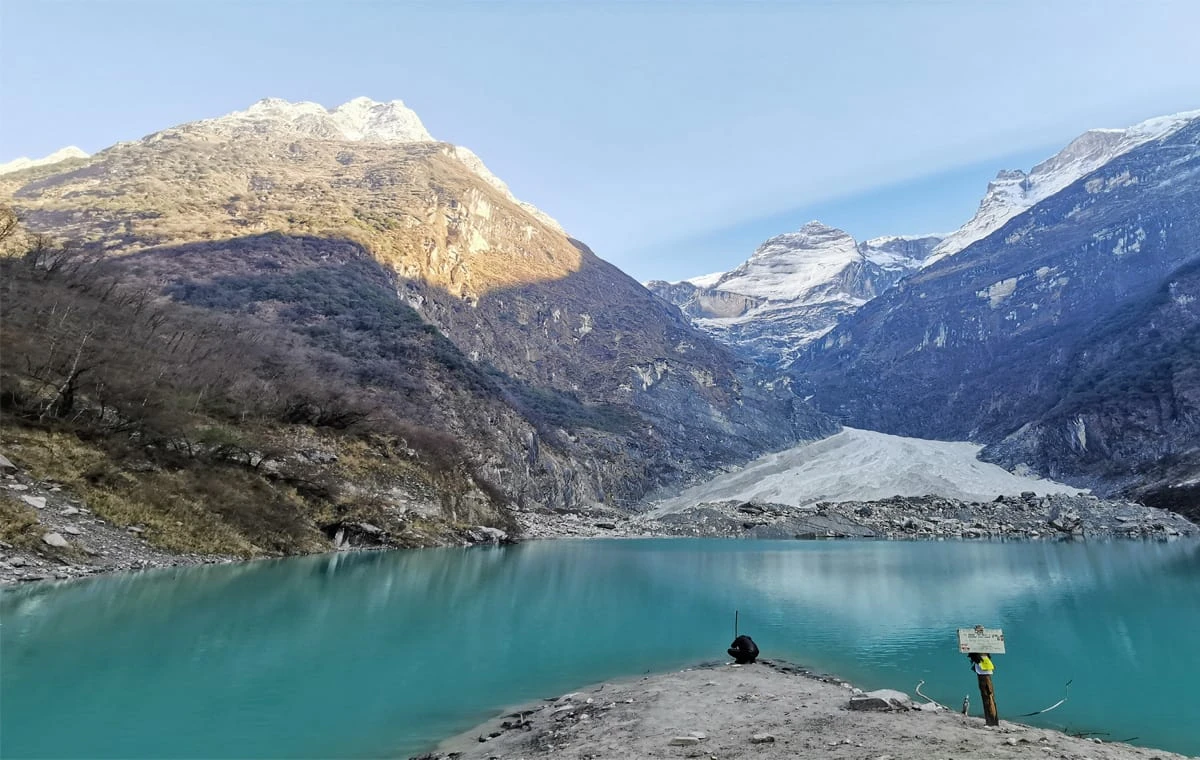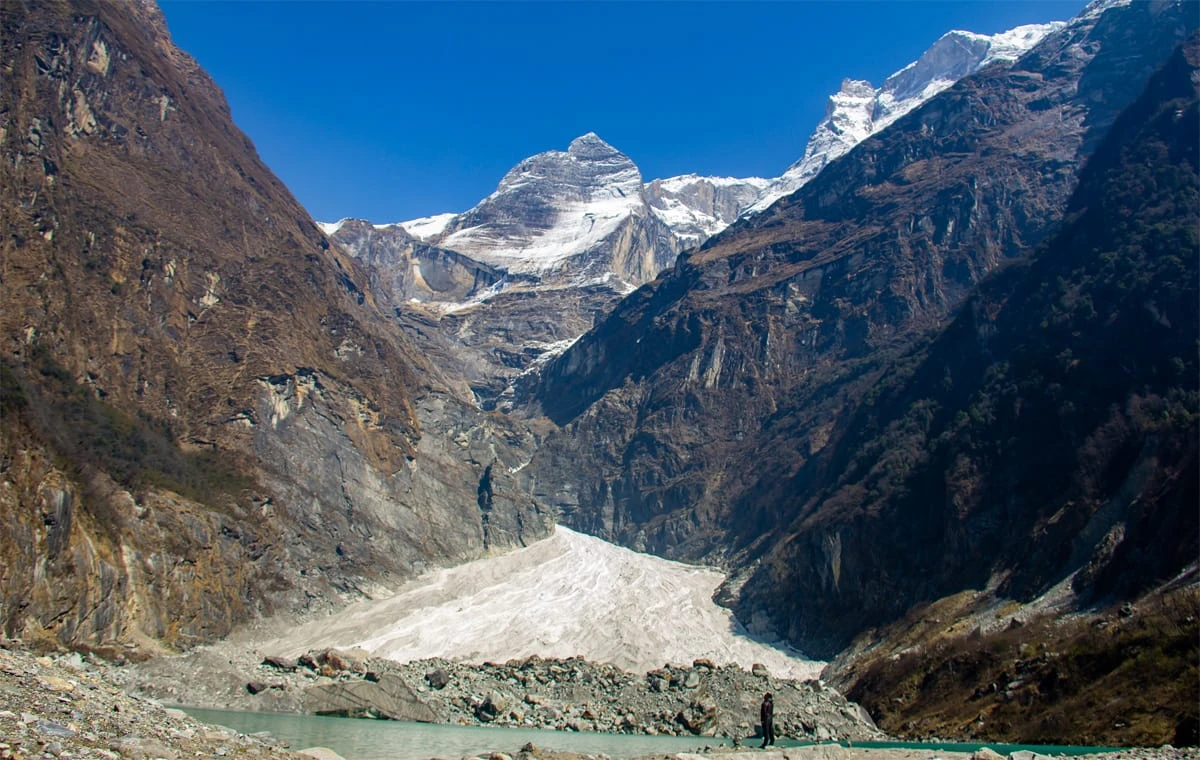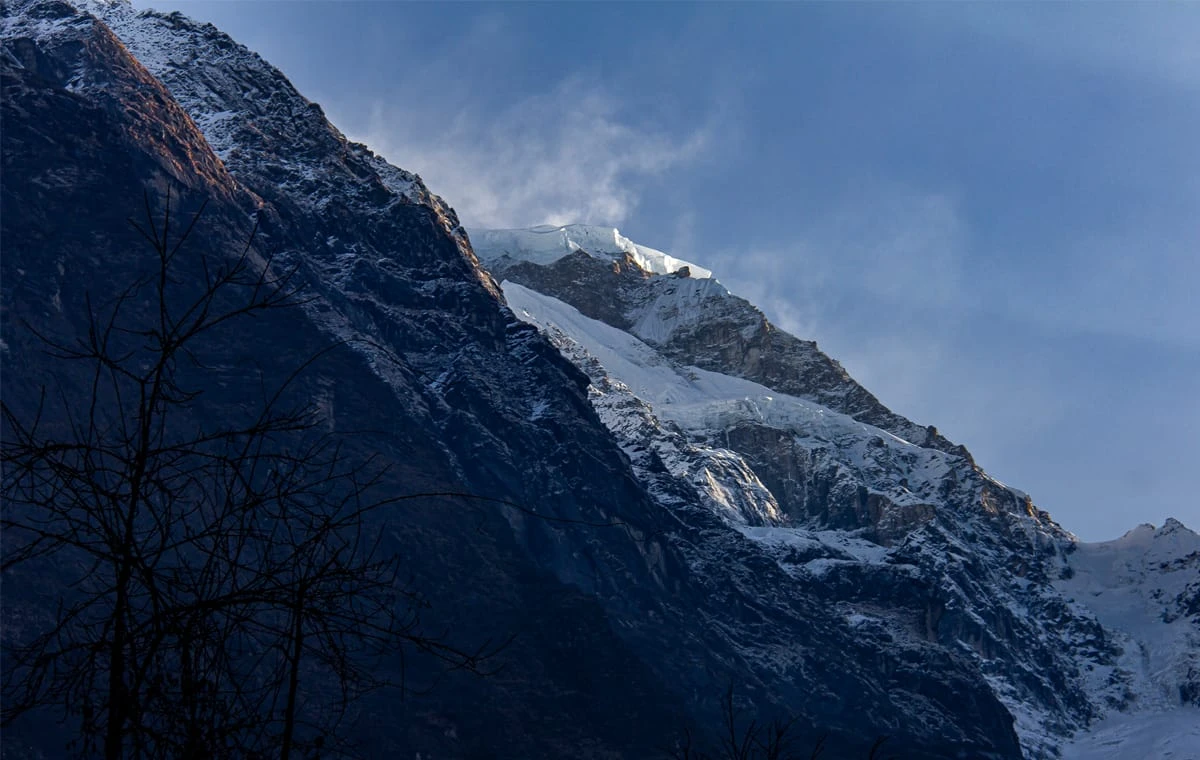Looking for a peaceful escape into the Himalayas without spending weeks on the trail? Well, the Kapuche Lake Trek is a perfect short adventure that takes you to Nepal’s lowest glacier lake in just 4 days. This hidden gem in the Annapurna region offers a mix of natural beauty, mountain culture, and quiet trails. This is ideal for both beginners and experienced trekkers.
On this journey, you'll walk through charming Gurung villages, pass terraced fields, and enjoy clear views of Annapurna and Lamjung ranges. Not just that, reaching the serene turquoise waters of Kapuche Lake, surrounded by towering cliffs and fresh mountain air, is a major highlight.
Besides adventure, natural beauty, and a lifetime of memories. This journey also teaches you gratitude, develops your personality, and makes you a skilled person. If you're short on time but still want a true Himalayan experience, this trek is for you. Let’s dive into a detailed Kapuche Lake Trek 4-day package.
Major Attractions of Kapuche Lake Trek
Kapuche Lake (2,546m) – Nepal’s Lowest Glacier Lake
Famous for its turquoise-blue water fed by the melting glaciers of Annapurna II, Lamjung Himal, and Machhapuchhre.Surrounded by dramatic cliffs and pristine wilderness, it is a hidden gem for trekkers.
Spectacular Himalayan Views During the Kapuche Trek
- Offers close-up views of Machhapuchhre (Fishtail), Annapurna II, Lamjung Himal, and Annapurna IV.
- Sunrise and sunset from nearby vantage points are breathtaking.
Gurung Villages & Culture on Kapuche Trek
- Trek passes through authentic Gurung settlements like Sikles, one of the largest Gurung villages in Nepal.
- Experience homestays, traditional dances, local food, and warm hospitality.
Sikles Village Exploration on Kapuche Trek
- Known for its stone-roofed houses, narrow alleys, and cultural richness.
- Great chance to witness traditional farming and weaving.
Experience the Off-the-Beaten-Path of the Kapuche Trek
- Unlike Annapurna Base Camp or Everest Base Camp, Kapuche Lake is still less crowded.
- Perfect for trekkers seeking solitude and authentic adventure.
Flora & Fauna on Kapuche Trek
- Dense forests of rhododendron, pine, and oak.
- Birdwatchers may spot the Himalayan Monal (Danphe – Nepal’s national bird) and other species.
Kapuche Lake Trek Map
Kapuche Lake Trek begins with a beautiful 3-hour drive from Pokhara to Sickles, which is a beautiful Gurung village located in the hills. From Sickles, trails go to the Huga village through the roads and rivers in the forests. This takes about 5 to 6 hours on foot.
The next day, an increase of 2 to 3 hours will bring you to the amazing Kapuche Lake. After enjoying the glacier, you will pull back in Sickle in 3 to 4 hours and then return to Pokhara on the way.
Route Overview: Pokhara → Sikles → Hugu Village → Kapuche Lake → Hugu → Sikles → Pokhara
Kapuche Lake Trek Best Season
The best time to trek to Kapuche Lake is Autumn (September–November) and Spring (March–May).
- Autumn (Sep–Nov) → Crisp weather, clear mountain views, post-monsoon greenery.
- Spring (Mar–May) → Blooming rhododendrons, mild temperatures, colorful landscapes.
- Monsoon (Jun–Aug) → Trails are slippery with leeches, not recommended.
- Winter (Dec–Feb) → Very cold, with chances of snow blocking the trail.
For the safest and most beautiful experience, choose Autumn or Spring.
Kapuche Lake Trek Difficulty
This trek is considered easy to moderate. Since it’s only 4 days long, anyone with a basic fitness level can complete it. However, the trails do involve uphill and downhill walking for several hours each day.
- Highest Altitude: 2,546 m (Kapuche Lake)
- Walking Hours per Day: 4–6 hrs
- Fitness Level Required: Basic
It’s a perfect trek for:
- Beginners who want their first Himalayan trek
- Families with children
- Travelers with limited time in Nepal
- Photographers and nature lovers
Kapuche Lake Trek Cost
The cost of the Kapuche Lake Trek depends on group size, services, and season. On average:
- 4 Days Package (Full Board): USD $450 – $600 per person
- Includes: Permits, guide, porter, accommodation, meals, transport, logistics
- Excludes: Personal expenses, insurance, drinks, and tips
Traveling with a group lowers the cost per person.
Kapuche Lake Trek Routes & Itinerary Options
4 days trek to Kapuche Lake in Nepal is definitely a popular choice. But you can also explore this lake, taking quite a long time. You will have extra time to enjoy nature closely and capture the moments as per your wish.
Route Overview: Pokhara → Sikles → Hugu Village → Kapuche Lake → Hugu → Sikles → Pokhara
Kapuche Lake Trek 5 days
The 5-day Kapuche Lake Trek begins with a drive from Pokhara to Soti, followed by a small trek to the beautiful Gurung village of Sicklas in 1 day. In 2 days, you will travel through green forests and rivers to reach the remote Huga village.
Likewise, day 3 takes you to the fantastic Kapuche lake, which is surrounded by glacial walls and alpine serenity. On the fourth day, you will return to Sickles with a beautiful downhill.
Finally, on the 5th day, enjoy a 2-hour walk in the morning, and then drive back to Pokhara. This way, your trip is completed with the fresh Himalayas.
5 Days Sikles Kapuche Lake Trek Itinerary
- Day 1: Pokhara → Soti → Sikles
- Day 2: Trek to Hugu village
- Day 3: Hugu → Kapuche Lake → Hugu
- Day 4: Trek to Sikles
- Day 5: Drive back to Pokhara
Kapuche Lake Trek 7 days
This 7-day Kapuche Lake Trek offers a balanced mix of nature, culture, and adventure. The journey starts with a scenic drive or flight from Kathmandu to Pokhara. The next day, enjoy a relaxing city tour around Pokhara.
On Day 3, you’ll drive to Soti and hike to the charming Gurung village of Sikles. The next two days will take you deeper into the mountains as you trek to Hugu. And then to the serene Kapuche Lake, the lowest glacier lake in Nepal.
After retracing your steps back to Sikles on Day 6, you’ll return to Pokhara and finally head back to Kathmandu on Day 7.
7 Days Sikles Kapuche Lake Trek Itinerary
- Day 1: Kathmandu → Pokhara (Drive/Flight)
- Day 2: Pokhara sightseeing & preparation
- Day 3: Pokhara → Soti → Sikles
- Day 4: Trek to Hugu village
- Day 5: Hugu → Kapuche Lake → Hugu
- Day 6: Trek to Sikles → Pokhara
- Day 7: Drive/Fly back to Kathmandu
Note: You can also combine Kapuche Lake with Annapurna Base Camp, Mardi Himal, or Annapurna Circuit for a longer trek.
Trekking Tips for Kapuche Lake Trek 4 Days
Following the tips below will ease your journey:
- Start light physical training (walking, jogging, or hiking) at least 2–3 weeks before the trek.
- Practice uphill and downhill walking if possible, as trails include both steep and gentle sections
- Pack light but smart, include essentials like hiking boots, layered clothing, a rain jacket, a hat, gloves, and a reusable water bottle
- Bring personal items like sunscreen, lip balm, wet wipes, power bank, headlamp, and basic medicine
- Break in your hiking shoes before the trip to avoid blisters
- Carry some cash (Nepali rupees) as ATMs are not available in the trekking area
- Travel insurance with emergency evacuation coverage is highly recommended
- Stay hydrated throughout the trek to avoid fatigue and altitude-related issues
- Hire a guide for safety, local knowledge, and trail support. It is highly recommended for first-timers
- Avoid plastic waste, bring reusable bottles and bags to keep the trail clean
- Respect local culture, greet with “Namaste,” ask before taking photos, and dress modestly in villages
- Start early each day to enjoy cool temperatures and better views
- Check the weather forecast before departure, as the trail can be slippery during heavy rain
Why with Breeze Adventures?
Breeze Adventure Pvt. Ltd. is a popular travel operating company in Kathmandu. We believe in offering more than just a trek. Actually, we deliver a personalized experience. With our knowledgeable local guides, flexible itineraries, and attention to detail, you’ll feel safe, supported, and inspired every step of the way.
Not only that, actually, we prioritize your comfort, handle all logistics, and make sure your journey to Kapuche Lake is smooth, memorable, and tailored to your needs. Whether you're a first-time trekker or a seasoned traveler, we’re here to make your adventure truly special.





